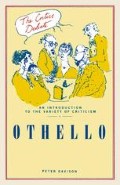Abstract
I DESCRIBE my approach as contextual. This is not a word I admire very much, but it does, I think, suggest that combination of the different critical milieux in which Othello may fruitfully be studied. I have in mind the social and historical context of the time when the play was written — either in the last months of the reign of Queen Elizabeth or, more probably, shortly after the accession of James I; the context of the play in performance, i.e. when embodied in physical action rather than read either without reference to the theatre or (still unsatisfactory) read ‘in the theatre of the mind’; and the context of our own time and place. This does not mean that problems that are usually only apparent in the study will be ignored. Intelligent reading of text alone is important not only for the student, but ought to be the basis of the work of every actor and director. Paradoxically, I shall focus on one of the play’s problems that is said to disappear in the theatre — double time. However, I shall think of this not as ‘a problem for the study’, ‘an academic matter’ (and ‘academic’ in our society is taken to mean, ‘it doesn’t matter’), but as part of the design of the play which Shakespeare might have expected the more perspicacious of his audience to spot.
Preview
Unable to display preview. Download preview PDF.
Copyright information
© 1988 Peter Davison
About this chapter
Cite this chapter
Davison, P. (1988). Contextual criticism. In: Othello. The Critics Debate. Palgrave, London. https://doi.org/10.1007/978-1-349-19430-8_8
Download citation
DOI: https://doi.org/10.1007/978-1-349-19430-8_8
Publisher Name: Palgrave, London
Print ISBN: 978-0-333-38695-8
Online ISBN: 978-1-349-19430-8
eBook Packages: Palgrave Literature & Performing Arts CollectionLiterature, Cultural and Media Studies (R0)

